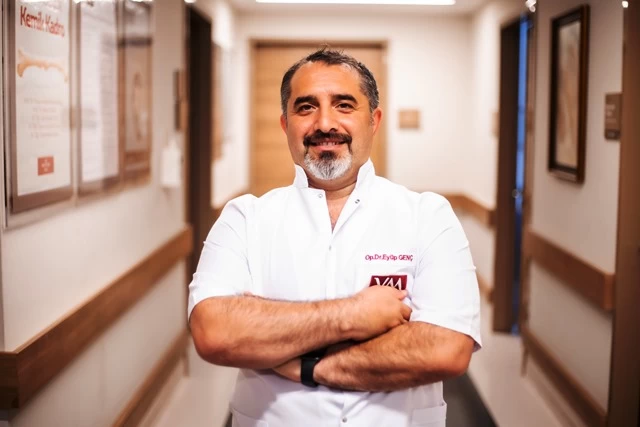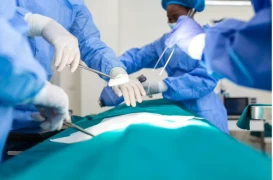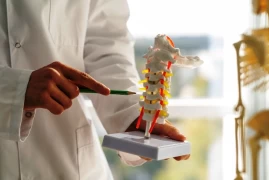
An Overview of Back Pain from a Neurosurgical Perspective
- An Overview of Back Pain from a Neurosurgical Perspective
- Causes of Back Pain
- Symptoms of Back Pain
- Treatment of Back Pain
- Surgical Treatment for Back Pain
- Surgical Treatment Options for Back Pain
- Preventing Back Pain
Back pain is one of the most common types of pain worldwide. It can affect people of all ages and significantly impact their quality of life. While back pain can stem from various causes, it is often associated with simple factors like muscle strains or sprains. However, it can also indicate a more serious medical condition.
Causes of Back Pain
There are numerous causes of back pain. Some of the most common reasons include:
- Sudden movement or overexertion during any activity (can lead to muscle strain or sprain and result in back pain)
- Weakening of muscles and ligaments that support the spine
- Posture abnormalities
- Heavy lifting
- Sudden movements
- Trauma
- Rheumatic diseases
- Spinal misalignment disorders like scoliosis and kyphosis
- Infections of the spine
- Tumors of the spine and spinal cord
Diseases affecting other organs such as the lungs, kidneys, heart, stomach, and intestines can also lead to referred back pain. In some cases, back pain can occur due to conditions like herniated discs, cervical radiculopathy, hip pathologies, or knee joint issues.
Symptoms of Back Pain
The symptoms of back pain can vary depending on the underlying cause. Generally, the pain is felt in one or more areas of the back. The intensity of the pain can range from mild discomfort to severe agony. Patients may report symptoms such as sharp, throbbing, burning, tingling pain, numbness, and weakness. Complaints like muscle spasms, stiffness, difficulty initiating movement, and immobility can negatively impact daily life. If back pain is accompanied by symptoms such as leg weakness or walking difficulties, it could indicate compression of neural tissue, warranting prompt medical attention. Seeking medical advice is crucial in such cases to determine the underlying cause.

Treatment of Back Pain
The treatment of back pain depends on the underlying cause. The patient's medical history is important and provides valuable information about the pain. Details like the onset time, nature, severity, and aggravating factors of the pain are informative. Neurological and musculoskeletal evaluations are necessary to assess the condition.
For patients with mild back pain, especially those resulting from physical strain, home treatments can be effective. These include:
- Resting
- Using pain relievers
- Applying heat to relieve muscle spasms
- Applying cold for traumatic back pain to reduce inflammation
- Correcting posture and adopting spine-healthy measures in daily life
If pain persists despite these measures, worsens, leads to neurological deterioration, or is accompanied by fever or weight loss, identifying the underlying cause is crucial. Tests such as MRI, CT, X-rays, EMG, and blood/urine analyses can help determine the cause and guide appropriate treatment options. For cases where neurological deterioration is absent, treatment options like physical therapy, manual therapy, botulinum toxin injections, neural therapy, epidural or intradiscal injections, and nerve blocks can be considered.
Surgical Treatment for Back Pain
When non-invasive methods and physical therapy fail to alleviate severe back pain, surgical options should be considered. Serious conditions such as herniated discs with neurological deterioration, spinal canal stenosis, spinal misalignment disorders, spinal infections, spinal trauma, and spinal cord tumors may necessitate surgical intervention.
Surgical Treatment Options for Back Pain
Once the cause of back pain is determined, surgical treatment options should be explored. These include:
- Discectomy: Surgical removal of a herniated disc that is causing compression between spinal vertebrae.
- Laminectomy: Removal of the bone at the back of the spine (lamina) to relieve pressure on the spinal cord.
- Vertebroplasty/Kyphoplasty: Procedures to restore vertebral height and strength in cases of vertebral fractures, often due to osteoporosis.
- Instrumentation (Spinal Fusion): Using rods, screws, and grafts to stabilize and realign the spine in cases of multiple-level laminectomies or severe spinal misalignments.
Several surgical techniques may be employed for conditions like spinal tumors, spinal infections, or spinal cord tumors. The primary goal of surgical treatment is to preserve neural tissue and prevent deterioration of the patient's health.
Preventing Back Pain
Before seeking treatment for back pain, the focus should be on preventing its occurrence by making lifestyle adjustments. After experiencing back pain, identifying and addressing the cause is crucial for effective treatment and preventing future occurrences. Some preventive measures include:
- Engaging in regular exercise
- Maintaining proper posture
- Limiting heavy lifting
- Avoiding sudden movements
- Sleeping on a mattress that supports spinal health
- Reducing stress
- Gaining the necessary muscle strength and flexibility for your job's demands
In conclusion, if you are experiencing back pain, it's important to consult a specialist to identify the underlying cause. Accurate diagnosis and treatment are crucial steps in managing and preventing recurrent back pain.






